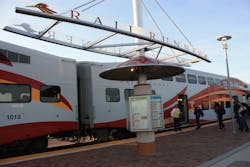The Rio Metro Regional Transit District (Rio Metro) is the primary regional transit provider for Bernalillo, Sandoval and Valencia counties in New Mexico, falling under the umbrella of the Mid-Region Council of Governments (MRCOG) . Rio Metro manages the New Mexico Rail Runner Express commuter rail and operates select bus routes in the three-county area.
One of the more interesting things going on in the region, Transportation Director Terry Doyle said, is the partnership between the Rio Metro and MRCOG, the metropolitan planning organization. They’re in the middle of the 2040 long-range transportation plan and Doyle said Rio Metro has participated at a high level with that and that Grant Brodehl, special projects planner for Rio Metro, wrote most of the transit section of the plan.
Future Growth
Doyle said the area expects to add just under half a million people to the three county area and just under 200,000 jobs to the area in that timeframe. The Metropolitan Transportation Plan (MTP) for the region is a long-range plan that is updated every four years. The list of anticipated transportation projects for the region in the plan needs to be fiscally constrained with the revenues they anticipate coming in to the area. “The horizon year for the plan is 2040,” said Doyle.
“One of the first steps on the transportation side that the MPO looks at is to consider impacts of growth on the existing infrastructure and see what happens,” explained Doyle. They look at 2012 base year conditions, a 2040 no-build option looking at the impacts of growth on existing infrastructure, and a 2040 build option, which considers the impacts of growth along with infrastructure investments.
The biggest congestion problems in the area relate to crossing the Rio Grande. And, when they look at the growth impacts with or without infrastructure investment, the river crossings are a huge problem in both situations.
“Some of the summary statistics after all that investment and the increase in traffic volumes, we see hours traveled increasing significantly, miles traveled increasing significantly, river crossing trips increasing significantly and average speeds decreasing significantly,” Doyle explained.
Historically development has happened and then transportation improvements chase it. This plan has done a much better job of bringing land-use in the discussion to address how they change the behaviors and preferences, and what roles different modes should play as they move forward.
Future Outlook
The key themes for the MTP, Doyle said, are changing travel preferences, limited funding available with an emphasis on roadway maintenance and preservation, and land use policy as a strategy for addressing transportation needs.
There has been a consistent growth in vehicle miles traveled, until 2004 when it leveled off and then began to decline. Since 2004 it has dropped 10 percent, lining up with the national average in drop in vehicle miles traveled per capita.
Doyle said, “Over the same timeframe, between 2005 and 2012, we’ve seen an 81 percent increase in ridership on transit and we’ve seen almost a 400 percent increase in passenger miles traveled by transit.” He continued, “A lot of that has to do with the Rail Runner coming in that timeframe; the average trip on Rail Runner being 40 miles.
“Every year we see some significant movement and the trend line is looking like as we put better transit out there, there’s definitely willingness and a demand to use it.”
The MPO did a travel survey as part of its update for the 2040 plan and they were able to cross tab the results of that based on age groups. Like other areas, millennials and seniors are traveling less daily miles than Generation X and the baby boomers. “I think we’ve been catering to this group quite a lot in how historically the plan in the Albuquerque metro area has been done,” Doyle said of Generation X and the baby boomers.
“There’s a lot of talk that this group [millennials] is a very important group as it relates to economic competitiveness and your ability to grow jobs, good paying jobs,” said Doyle. “And obviously this group,” he said of the baby boomers, “is the group that is an ever-growing group.
“I think we might need to look at these two groups as they are the moving groups that we want to grow.”
When they looked at the changing housing preferences, Mid-Region Council of Governments and MPO Transportation Planner Aarron Sussman said they were surprised to see when they asked people where they would like to live in the future, every single age group expresses preference for more urban and semi-urban options.
Sussman said you hear all these assumptions about preferences by age group, but this was the first time they really looked at local data and they were surprised how much that applied locally, how much it mirrored national trends and preferences.
With no new bridges being proposed and an enormous amount of residential growth to the west.
“We see some of these changing preferences, it gives an extra rationale for looking at maybe other types of growth patterns,” said Sussman. “We’ve developed this preferenced scenario, looking at additional emphasis of growth in specific locations, particularly around transit — transit being the real organizing principal in a lot of respects.”
He said they identified a series of activity centers and transit nodes and how do they incentivize or emphasize development in those locations. He and Doyle emphasized they aren’t talking about enormous changes in growth patterns. It’s also not about preventing or precluding growth, but where growth takes place in these communities, how close is it to amenities?
Today there are a lot of options for people who want to live in rural and suburban lifestyles and over the life of the MTP, Doyle said they create more options for people who want to live in urban areas and target some specific locations. “Doing so will lead to better transportation, improved air quality and minimize development in at-risk locations,” he said.
He also pointed out, “The scale of development we’re talking around here, this isn’t East Coast scale … these are some lofts in the downtown areas. They exist today and the density we’re talking about isn’t anything very staggering.
“I think when the MPO looks at this and the member agencies look at this, this stuff we can point to around town.” He added, “It’s nothing that really changes the character of neighborhoods drastically.
Reflecting on the 2040 MTP and Rio Metro’s 2015 visioning effort, Doyle said, “I think we’ve really worked hand-in-hand with the MPO to push this preferred package out there and I think it’s been received really well by the member agencies.”
Rapid Transit
For the future of transit in the Albuquerque area they are looking at a network of high-capacity, high-frequency premium service. Rio Metro and the city of Albquerque are pursuing BRT along Central Avenue and University Boulevard as two parts of one system, and future expansions. The two agencies are collaborating on funding, the design of stations and buses and to ensure that the service will be coordinated to best serve the region.
The elements they’re looking at are operating in fixed guideway with stations, off-board fare collection on the station platforms, priority signaling, real-time passenger information and enhanced station amenities.
Doyle said the city of Albuquerque is the lead and the Central Avenue BRT project has been accepted into the FTA Small Starts/New Starts process for project development. “The first minimum build segment we’re looking at a capital cost in the neighborhood of $120 million,” said Doyle. “They’re looking at getting somewhere in the neighborhood of $60-70 million out of the FTA Small Starts/New Starts program for that.”
HDR Vice President Peter Brakenhoff, a managing principle in New Mexico, said they have a contract with ABQ Ride and they’ve been involved since the project came out. “Overall, the corridor along Central Avenue is a very bust transit corridor,” he said. “It was a good fit for bus rapid transit.” And, he said there are plans for future phases, tying into this central corridor.
Rio Metro has done an alternative analysis for a BRT in the area that links the University of New Mexico main campus, the Central New Mexico Community College, the airport and with connections on the Central Avenue corridor. They’re also looking at one that would run across the river up in the Rio Rancho area.
“Those three BRTs we’re looking at collectively with a capital cost of $230 million and an annual operating budget with the headways that we want [7-15 minutes] at about $15.3 million,” said Doyle.
The operating revenue for the Central Avenue piece is predominantly coming out of the service ABQ Ride currently runs out of there. Central Avenue service, with two rapid ride services ABQ Ride runs and the local service that it runs, accounts for about 41 percent of its ridership. “So it’s a high-use corridor,” stated Doyle.
“We’re really working together to make these things line up,” Doyle explained. “We’ve put a lot of weight as a transit district and as a board, behind this Central Avenue Project. We kind of see this as it’s got the ridership on it already and it’s got the most potential to be a huge success in FTA’s eyes and a huge success for this region in moving forward on a lot of what we’re talking about here.
“We’re putting a lot of effort behind making that a huge success and making sure we have the funding in place.”
Brakenhoff said the team did a trip to Cleveland to meet with Greater Cleveland Regional Transit Authority (RTA) staff and see the operations of the HealthLine.
Dedicated bus lanes are something that they see as important to the project. “Right now,” Brakenhoff said,” we’re looking at dedicated bus lanes with the buses in the center median.
“I think the biggest thing with any project is what is the impact on the neighborhood, “ said Brakenhoff. “Looking at it from a beautification perspective. Is there any landscapting improvements? Wider sidewalks? What’s the overall flow of the corridor if this would be implemented?
“Through the public involvement that we’ve gone through and educating everybody that’s involved, it’s been a very positive outpour of where we’re going, what we’re doing and where we’re going."
Currentlyl the FTA is reviewing the environmental document. The design is at about 60 percent and in late spring, early summer, they expect to go out for RFP for the construction. The goal is to get it into service in the fall of 2017.
Vet Connect
Under the umbrella of the Mid-Region Council of Governments, Rio Metro has different opportunities to apply for a variety of grants for different programs. Rio Metro Graphic Designer Michael Jiron heard about one of the programs and took the lead on the project.
The grant from the Federal Transit Administration (FTA) was for two things: connecting veteran agencies and transportation opportunities and creating the infrastructure for a one-click/one-call center. They went ahead toward the call center and put in a new phone system, a new email server and started moving forward on the project. The question, Jiron said, was what were they going to do for longevity?
They were about 25 percent into the project planning and there was no more funding coming from the FTA.
They needed staffing and they needed partners. They looked at setting up a work-study site using veterans that were high in their degree plan to come in and answer calls and to work on the database backend of the website.
The FTA grant was for $335,500 and the local match was $75,000. Jiron said, “Why spend $400,000 and get everybody involved to just send them away after they come here on one visit?
“I had a conversation with NMDVS [New Mexico Department of Veteran Services]. I was really looking for a piece of the website because I want to divide it into two things: the physical needs and social needs.”
They were looking at a leadership task force where they would develop community leaders and bring veterans in and use a template to work in their community building swingsets or filling potholes, working on cars, building gardens, those types of things. It was helpful and therapeutic and would help them be less isolated.
“That person has their leg fixed, well that’s not enough,” Jiron said. “They can go to the store, they still haven’t made a personal relationship, which is the key to get them out of isolation. Now we have that third part.”
NMDV had been working at establishing this type of product for several years and when they saw it, asked what MRCOG needed. And Jiron said: money, staffing and longevity – how do we keep this going?
“I was looking at their website and I said, what if we create this $400,000 product and we give it to you for free. We give you this,” Jiron said. “We brand your agency and you take this as a way to re-interface with New Mexico.
“They just loved that idea,” he stated. “All of that infrastructure we had put together is becoming the new brand of NMDV and now this project is going to have longevity.”
The website is still in the development phase and will be handed over to NMDVS in about June.
The Transit Piece
With a solid plan in place to keep the project going, the next step was what to do between now and then, when NMDV releases the website. Jiron said, “We’ve got this website, we’ve got partners, people are excited about what we are doing. What do we do in the interim?”
Rio Metro had wanted to do a veteran pass and they started talking to others that were doing that type of program and looked at the numbers.
Jay Faught, marketing director for Rio Metro said they also saw it as a way to increase ridership. With new riders being able to ride for free, they’re probably not going to ride alone; they’re going to bring somebody with them.
Jiron said the pass allowed Rio Metro to interface with the public on this project they’ve been working on. “We have something to show for our work.” He added that with the partnerships between Rio Metro and other transit providers, with the Rio Metro pass they can get on most any other system in the region for free.
They created mobile ID machine units, similar to getting your driver’s license, so that it can’t be faked. Jiron said it protects the program and also makes people feel like they’re getting something of substantial value. They take the mobile units out to various events. The unit sets up in about 10 minutes and they’re ready to start making passes.
Another important step for this was partnering with the New Mexico VA. Jiron said the VA is a federally funded organization and they don’t let anyone advertise there. So they went in and talked to them about the possibility of Rio Metro going in during one of the events. “We’re not trying to sell them tickets, this doesn’t benefit us,” he said.
Jiron said it was important to partner with the VA because veterans need a VA card to get the pass. They were able to take a kiosk to the VA, the VA stores it and Rio Metro goes in twice a month to distribute cards. The kiosk is front and center by the benefits department window and they’re even on video boards, in printed material and have an online presence with the VA
While Rio Metro’s part in the grant will end in about 8 months, the pass will likely remain. “We’re calling this a pilot program right now,” Faught explained. “It’s an annual pass that will expire on December 31. We’re evaluate that later this year, look at our ridership, all those kinds of things.
“I don’t see it going away, but we want to be sure we have all the data.
Currently there are approximately 2,100 passes that have been handed out.
Onboard Express
Rio Metro has a partnership with a local publisher to produce Express magazine, Rail Runner’s onboard magazine. It’s put out twice a year with Rio Metro producing a lot of the content for it. Riann Martinez, Rio Metro marketing specialist, said, “It works out really well to our benefit because we don’t have to pay for it.”
Martinez said the content includes six or seven stories and things like Rio Metro’s calendar of events, events Rail Runner can connect you to, regular schedule, and the holiday schedule.
Faught explained the publishing company sells advertising for it and that’s how they get their money.
They had started this several years ago with the local newspaper but they had a problem selling it. Since switching to the publishing company, which calls local contacts on behalf of Rail Runner when selling advertising, there has been no problem in selling it.
“The benefit of working with this group, in addition to it being onboard the train, is they send it out – direct mail – to two zip codes that we choose,” Faught said. “Over a course of a couple years, everybody is going to get something from us. And we don’t pay anything for that.”





